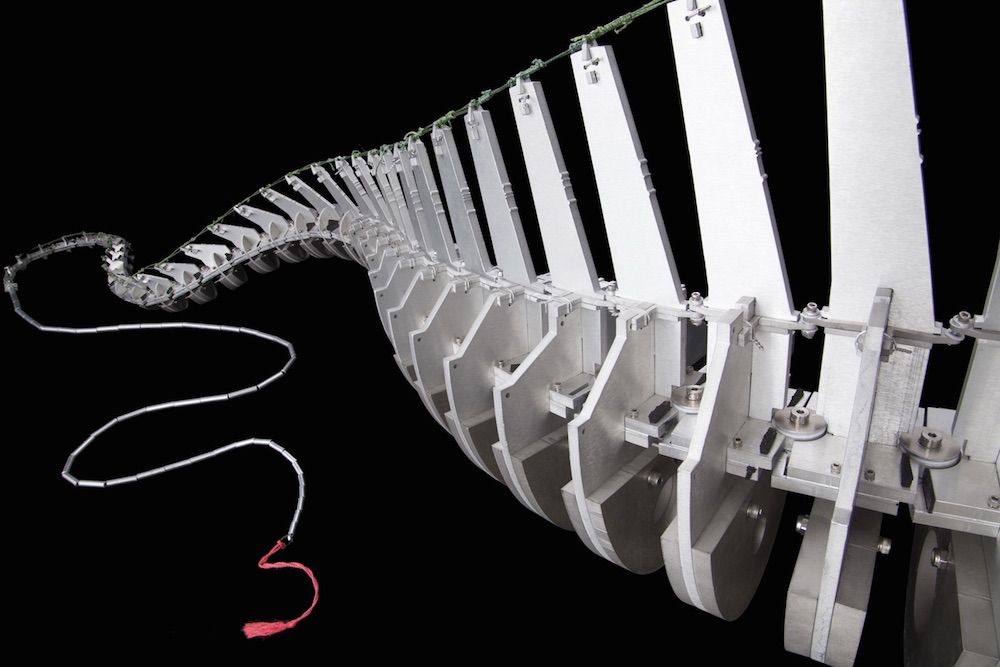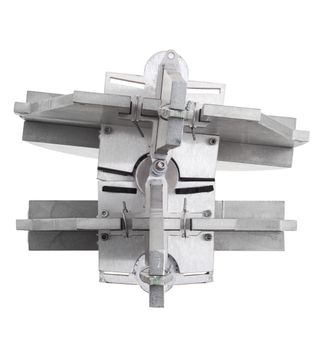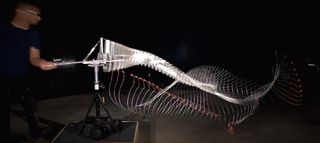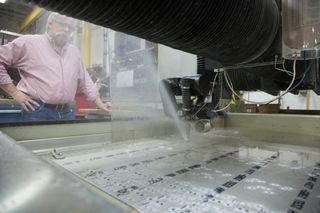Dinosaur's Tail Whips Could Have Cracked Sound Barrier

When an Apatosaurus dinosaur slapped its impressively long tail onto the ground, other beasts likely listened. Turns out, the long-necked dino may have broken the sound barrier with its tail whips more than 150 million years ago.
Paleontologists have all but gone back in time to prove the sonic booms, by creating and test-slapping a model tail made of aluminum, stainless steel, neoprene and Teflon.
The 12-foot-long (3.6 meters) model is just one-quarter the size of a sauropod tail, but it's still able to produce the distinctive crack that indicates it can break the sound barrier when whipped around, said Nathan Myhrvold, founder and CEO of Intellectual Ventures, a company that invests in technology patents and research. [In Images: An Apatosaurus Discovery]
"It is, of course, impossible to create a real tail out of flesh and blood," Myhrvold told Live Science. "But this model's every single bone — there's 82 bones in the tail. It has the correct dimensions, it has the correct joint angles and then each [vertebra] has weights on it to simulate the weight of the flesh."
If the model is true, it means "Chuck Yeager was not necessarily the first resident of Earth to go faster than sound," Myhrvold said. "Of course [the Apatosaurus] didn't get their whole bodies [moving] faster than sound, just one tiny part. But, hey, it still counts."

Myhrvold has tinkered with the tail for nearly 20 years. In the mid-1990s, when he worked as the chief strategist and chief technology officer of Microsoft Corp., he came across a book by Robert McNeill Alexander, a renowned zoologist known for his studies in dinosaur locomotion.
One sentence in the book caught Myhrvold's attention.
Sign up for the Live Science daily newsletter now
Get the world’s most fascinating discoveries delivered straight to your inbox.
"[Alexander] wondered if the tails of the Diplodocid sauropods acted like a bullwhip to make a big noise," Myhrvold said. "I thought we should find that out. It was such a cool idea."
Sauropods are the large, herbivorous dinosaurs famous for their long necks and long tails. Myhrvold focused on the Apatosaurus genus, a group of enormous dinosaurs that lived from about 155.7 million to 150.8 million years ago during the Late Jurassic.
In 1997, he co-wrote a study with Canadian paleontologist Philip Currie in the journal Paleobiology suggesting that, based on a computer model, the tail of Apatosaurus louisae could have reached supersonic speeds, "producing a noise analogous to the 'crack' of a bullwhip," he wrote in the abstract.
Apatosaurus, and other sauropod dinosaurs with incredibly long tails, may have supersonically whipped their tails for purposes of defense, communication, same-species rivalry or courtship, Myhrvold said.
But the computer model had its skeptics.
"When the paper came out, my comment to him was 'garbage in, garbage out,'" said Kenneth Carpenter, the director and curator of paleontology at Utah State University Eastern Prehistoric Museum, who was not involved with the study.
"[Myhrvold] kind of bristled a little bit, but I said I would be more willing to accept it if a scale model were to be built and prove that it could be done," Carpenter said.
So, Myhrvold and his colleagues built a model, and presented it at the 75th annual Society of Vertebrate Paleontology conference in Dallas on Thursday (Oct. 15).
Metal model
It took nine months to design, build and test the 44-lb. (20 kilograms) model, which is attached to a "dinosaur butt" stand-in: a camera tripod.
When a person gives the tripod handle a series of quick tugs, the tail swings around and "cracks," indicating it has broken the sound barrier. The team wanted exact measurements, so they filmed the tail using a high-speed camera that could take between 6,000 and 8,000 frames per second. [Paleo-Art: Dinosaurs Come to Life in Stunning Illustrations]
"Each frame would show us a position, and then by calibrating the position, you could figure out where it was and then calculate the speed," Myhrvold said.

At sea level, the speed of sound is 1,126 feet per second (340 meters per second). The model tail topped that. Calculations from the high-speed images indicate that the tail traveled at least 1,181 feet per second (360 meters per second), Myhrvold said.
However, Carpenter still has some criticisms of the model. Myhrvold, if anything, seems energized by the challenge, and said he and his colleagues would continue to work on the model before publishing the results in a journal.
Lingering problems
Myhrvold and Carpenter have both channeled their childlike curiosities toward figuring out whether certain sauropod tails could move at supersonic speeds.
"We've never grown up, we're constantly always asking why," Carpenter said. "He's proposing an answer to the 'why' question and I'm saying, 'Why do you think that's still accurate?' It's a back-and-forth."

For instance, Carpenter said the new model lacks some of the subtleties that exist in sauropod tails. It doesn't have structures that connect one vertebra to the next, which would probably restrict the side-to-side motion of the tail.
"Without that, the tail that he's got is probably too flexible," Carpenter said.
Moreover, adding skin and muscle would also restrict the tail's motion, he said. And, at the end of the tail, Myhrvold included a "popper" made of treated leather.
"In a bullwhip, when you crack it, you've got this wave that rolls down its length," Carpenter said. "When it gets to the popper, the popper changes direction really fast. That's what causes the crack, because it moves at supersonic speed at that point."
But if a sauropod were to really crack its tail at a supersonic velocity, the skin at the end would probably break, bleed and develop scabs and inflexible scar tissue, Carpenter said.
"I have a hard time envisioning evolution taking sauropod tails down a path of having a structure that could only be used a few times and then is worthless," he said.
But, once Myhrvold and his colleagues advance the model, "I have great hopes that the next model will be more accurate as far as the living animal goes," Carpenter said. [Gory Guts: Photos of a T. Rex Autopsy]
Breaking the barrier
Other paleontologists said the model is part of a larger movement in paleontology. Physical models of such dinosaur parts were expensive, if not impossible, to make in the past. Now "we can easily scan fossil material and 3D-print scale replicas," said Matthew Cobley, an educator in the School Programs department at the Natural History Museum of Utah, who was not involved with the new research.
"It's great to see someone build a working physical model of something that we could previously only test through computer simulations," Cobley said.
It's still not 100 percent certain the ancient animal could actually break the sound barrier, "but it definitely shows that they could use their tails as a defense," Cobley said. "If their tails could even reach a fraction of the speed needed to make a sonic boom, it would make for a very effective weapon against any attacker."
Kenneth Lacovara, a professor of paleontology at Rowan University in New Jersey, said the model tail may not "contain all the complexities of nature, but I think it's a good approximation."
He also had some advice for the model. The tripod operators moved the model in a way that mimicked a dinosaur waggling its butt, but in reality, the dinosaur would have largely relied on two major sets of muscles to move its tail, Lacovara said.
Myhrvold has no problem listening to these recommendations.
"Every little boy is interested in dinosaurs, and I just never lost that," Myhrvold said.
Follow Laura Geggel on Twitter @LauraGeggel. Follow Live Science @livescience, Facebook & Google+. Original article on Live Science.

Laura is the archaeology and Life's Little Mysteries editor at Live Science. She also reports on general science, including paleontology. Her work has appeared in The New York Times, Scholastic, Popular Science and Spectrum, a site on autism research. She has won multiple awards from the Society of Professional Journalists and the Washington Newspaper Publishers Association for her reporting at a weekly newspaper near Seattle. Laura holds a bachelor's degree in English literature and psychology from Washington University in St. Louis and a master's degree in science writing from NYU.











